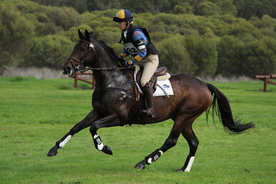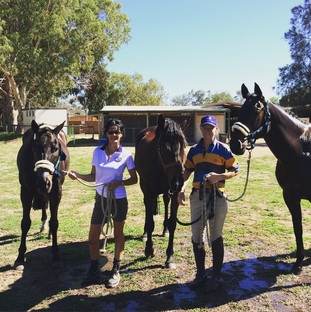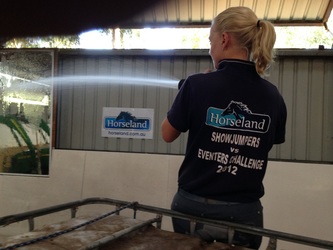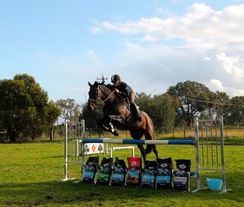
It’s a sight we see at many a horse event – hot, sweaty horses standing in line waiting for their turn at the wash bays. Debatably, it’s a great time for your horse to have a pick of grass and you a chat to your friend or debrief your round with a loved one, but what is happening on the inside of your horse?
While he may appear to be enjoying a pick of grass as he waits his turn for a wash, on the inside his temperature is rising and every degree counts. If a horse’s body temperature rises just 3 to 4 degrees from normal, the temperatures within working muscles may be as high as 43 degrees celcius. At this temperature the proteins in the muscle begin to cook and break down. Doesn’t sound ideal does it?
Animal and exercise physiologist, Professor Michael Lindinger explains: “It only takes 17 minutes of moderate intensity exercise in hot, humid weather to raise a horse’s temperature to dangerous levels. That’s three to 10 times faster than in humans.”
Horses are more susceptible to heat stress for several reasons. Most obviously, they are larger and have a higher percentage of active muscle than humans do during exercise. Muscles produce a lot of heat when they are being used.
While he may appear to be enjoying a pick of grass as he waits his turn for a wash, on the inside his temperature is rising and every degree counts. If a horse’s body temperature rises just 3 to 4 degrees from normal, the temperatures within working muscles may be as high as 43 degrees celcius. At this temperature the proteins in the muscle begin to cook and break down. Doesn’t sound ideal does it?
Animal and exercise physiologist, Professor Michael Lindinger explains: “It only takes 17 minutes of moderate intensity exercise in hot, humid weather to raise a horse’s temperature to dangerous levels. That’s three to 10 times faster than in humans.”
Horses are more susceptible to heat stress for several reasons. Most obviously, they are larger and have a higher percentage of active muscle than humans do during exercise. Muscles produce a lot of heat when they are being used.

Horses also rely on sweating to cool them off. They can sweat 15 to 20 litres per hour in cool, dry conditions and up to 30 litres per hour in hot, humid conditions. Unfortunately for them, though, only about 25% to 30% of the sweat produced actually gets evaporated and therefore helps the cooling process. The rest just drips off the horse’s body. By comparison, up to around 50% of the sweat that humans produce is effective in cooling us by evaporation.
Just because your horse is not puffing any more doesn’t mean his temperature is not still rising or that he has already ‘recovered’. It simply means he is no longer puffed. Unlike dogs, horses rarely ‘pant’ to cool themselves. In fact, for horses panting is only effective for cooling if the ambient temperature is at least 5 degrees cooler than their body temperature.
Back to our horse having a pick of grass waiting in line for the hose. He’s still hot, and getting hotter by the minute. The horse’s temperature can keep rising for 10 or even 20 minutes after finishing the cross-country course. So why not bring yourself a bucket and sponge and get prepared before you head out on course? Hosing your horse is probably a bit easier but the bucket and sponge works just as well and is usually more effective in cooling your horse – especially if it means he gets some cooling attention sooner.
At FEI (internationally graded) events you’ll have to do what’s known as aggressive cooling at the finish of the cross-country course and you’ll be supervised by stewards and vets and only allowed to go once your horse’s temperature and heart rate are almost back to normal. We’ll talk a little more about aggressive cooling later. But for now, what should you do at the lower levels?
If you can transport water in your truck or float then you’re winning. All you have to do now is fill up some buckets before you head out to the warm up arena and you’re ready to cool your horse on return to the float. If you can’t carry water with you then fill up your from the wash bay or tap well ahead of the rush so you can get onto the cooling job as quickly as possible on return to the camp.
Just because your horse is not puffing any more doesn’t mean his temperature is not still rising or that he has already ‘recovered’. It simply means he is no longer puffed. Unlike dogs, horses rarely ‘pant’ to cool themselves. In fact, for horses panting is only effective for cooling if the ambient temperature is at least 5 degrees cooler than their body temperature.
Back to our horse having a pick of grass waiting in line for the hose. He’s still hot, and getting hotter by the minute. The horse’s temperature can keep rising for 10 or even 20 minutes after finishing the cross-country course. So why not bring yourself a bucket and sponge and get prepared before you head out on course? Hosing your horse is probably a bit easier but the bucket and sponge works just as well and is usually more effective in cooling your horse – especially if it means he gets some cooling attention sooner.
At FEI (internationally graded) events you’ll have to do what’s known as aggressive cooling at the finish of the cross-country course and you’ll be supervised by stewards and vets and only allowed to go once your horse’s temperature and heart rate are almost back to normal. We’ll talk a little more about aggressive cooling later. But for now, what should you do at the lower levels?
If you can transport water in your truck or float then you’re winning. All you have to do now is fill up some buckets before you head out to the warm up arena and you’re ready to cool your horse on return to the float. If you can’t carry water with you then fill up your from the wash bay or tap well ahead of the rush so you can get onto the cooling job as quickly as possible on return to the camp.

So what is aggressive cooling and how do we do it? Firstly, try to set up your cooling station in some shade if possible, and if there is a breeze take advantage of it! The best way to cool a horse quickly is to remove his tack as quickly as possibly and start repeatedly applying cool water (iced if required) while scraping off the excess water immediately. The water will heat up as soon as it touches the horse and by scraping it off you’re removing that heat. Repeating this over and over means you’re effectively removing all the heat from the body. Do this until the water comes off fairly cool. You can cool the horse by two degrees in about 10 minutes with this technique.
If your horse is ticklish or can be agitated following a cross-country round you might need to enlist the help of a friend – but make sure they don’t get nipped! If your horse is anything like my lovely Let’s Impress you’ll need a special person designated to holding on to him. My aunt has this job and she’s developed the ‘straight elbow technique’ to ensure she doesn’t get bitten in the moments after cross-country when Let’s Impress is feeling particularly pleased with himself and doesn’t want to be covered in ice cold water!
If your horse is ticklish or can be agitated following a cross-country round you might need to enlist the help of a friend – but make sure they don’t get nipped! If your horse is anything like my lovely Let’s Impress you’ll need a special person designated to holding on to him. My aunt has this job and she’s developed the ‘straight elbow technique’ to ensure she doesn’t get bitten in the moments after cross-country when Let’s Impress is feeling particularly pleased with himself and doesn’t want to be covered in ice cold water!

It can be useful to give the horse a little walk in between washing and scraping sessions to take advantage of the breeze and help him to relax. Sometimes the wash down area is so stressful for horses it can contribute to keeping their heart rate quite high!
In extreme heat we’ll often have at least three people and sometimes as many as five people on the job of cooling the horse after cross-country. One person to lead, and one or two people on each side to apply and scrape the water. This way you can keep the horse moving while cooling as quickly as possible.
Once your horse is cool you can offer him some water, and do other post-cross-country routines such as giving him electrolytes or icing his legs. Some people like to get ice on their legs straight away after the cross-country and it will help a little bit in the cooling process but unless you have endless good willed helpers (that are happy to get very wet and possible trampled!) the time it takes to get them on is precious cooling time and they may also hinder the horse’s ability to be walked during the cooling process.
Remember, you’re going to get wet, and so are your boots and your helpers, but your horse has given you everything on the cross-country course so make sure you do your bit to help him recover as well as possible!
Happy eventing!
In extreme heat we’ll often have at least three people and sometimes as many as five people on the job of cooling the horse after cross-country. One person to lead, and one or two people on each side to apply and scrape the water. This way you can keep the horse moving while cooling as quickly as possible.
Once your horse is cool you can offer him some water, and do other post-cross-country routines such as giving him electrolytes or icing his legs. Some people like to get ice on their legs straight away after the cross-country and it will help a little bit in the cooling process but unless you have endless good willed helpers (that are happy to get very wet and possible trampled!) the time it takes to get them on is precious cooling time and they may also hinder the horse’s ability to be walked during the cooling process.
Remember, you’re going to get wet, and so are your boots and your helpers, but your horse has given you everything on the cross-country course so make sure you do your bit to help him recover as well as possible!
Happy eventing!

 RSS Feed
RSS Feed
